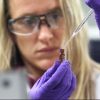Medical device manufacturers are under serious pressure to get in gear and conduct their pre-clinical device testing—and fast. Europe’s Medical Device Regulation (MDR) will require submissions to be approved by May 26, 2020 to maintain a presence in the EU medical device market. If an extension was granted, Medical Devices Directive (MDD) and Active Implantable Medical Device Directive (AIMDD) certificates will be void as of May 27, 2024.
The changes introduced by ISO 10993-1 in the United States and Europe’s MDR aim to close regulatory gaps across markets and establish a globalized set of safety requirements. Every medical device, including legacy products that have been on the market for years, needs to be supplemented with new data and updated evaluations. It is estimated that more than half a million different devices currently CE marked under Europe’s medical device directive (MDD) will need to be recertified under the new MDR. Given the amount of work to be done and a shrinking number of notified bodies to review submissions, time is of the essence. Device manufacturers can’t afford to put off MDR preparation efforts any longer.

Failure to comply by the deadline will result in costly consequences, including having to retest devices or pull products from the market altogether; but thoughtful planning and partnership can help avoid challenges and delays. The following are some critical questions for your internal team to consider while preparing product portfolios and selecting a contract research organization (CRO) to carry out pre-clinical device safety testing.
Internal Responsibilities: Role of the Recruitment Committee
Before partnering with a CRO or laboratory testing facility, it is important to assemble a multi-disciplinary team of specialists from across your organization. This internal team will focus on MDR preparation efforts and regulatory education. Since MDR is multifaceted, your team should include experts from quality, product, regulatory affairs and engineering departments to ensure that nothing is overlooked or forgotten. Together, they can conduct a gap analysis on your product lines and identify any missing or outdated information in the technical files. To comply with the new requirements, notified bodies will not accept historic product data or performance reviews alone, which is why it is important to do this work before approaching a CRO. The following are some guiding questions to help kick off internal efforts and the gap analysis.
- How old is the device?
From a timing standpoint, begin with legacy devices that have been on the market longer is wise. The pre-existing data for these devices will likely be more outdated and may require more legwork than newer products that have undergone testing more recently. - When was the device tested last? What were the results?
Even products that were tested three years ago may need to be retested to fully comply with the latest standards. However, it will still be beneficial to include all historical data in your technical file. Providing a track record of regulatory success will show regulators that you are dedicated to positive outcomes and patient safety. A comprehensive device history will also help your CRO develop and drive your test plan forward. - Have changes been made to the device since the last time it was tested?
Not only is it important to note any alterations that have been made to the device itself since it was last tested, but you must also account for any changes in suppliers or manufacturing and sterilization processes. Device changes could impact chemical makeup or potential risk outcomes, and regulators will be looking for data that supports the safety of all individual material components. - Have there been any patient safety issues linked to the device?
Any evidence of past performance problems that have put patients at risk will be an automatic issue for regulators, if you are unable to show that the issues have been sufficiently rectified. In these situations, investing in robust testing is the best course of action. - Is the design history file complete and ready for the lab or CRO?
Your internal team should compile existing data on all of the materials and processes that go into making your devices before selecting a testing partner. A complete design history file includes information on any adhesives, additives, colorants, polymers and manufacturing aids used on or in the product, as well as the procedures used in the manufacturing and sterilization of the device. Having all of this data in one place will help you and your testing partner evaluate what tests are necessary to verify safety as efficiently as possible.
EU MDR Implementation Strategies (A Virtual Event) | February 4–6, 2020 | Learn from industry experts, notified bodies and EU MDR consultantsEvaluating the Pool of Candidates: Questions to Vet Testing Partners
Once your team has gathered all of the necessary product information and technical file data, it is time to develop a pre-clinical device safety test plan. Many manufacturers opt to outsource their regulatory testing needs to a CRO as a way to accelerate the process and get devices in front of regulators before their competitors. CROs are instrumental resources, but they’re not all created equally. Here are some questions and considerations that will help you decide who to trust with your testing needs.
- What are your in-house testing capabilities?
Under MDR, a complete risk assessment evaluates chemical, toxicological and biocompatibility results. CROs that are able to complete all three analytical test methods in-house are preferable, as doing all testing in one place increases efficiency, allows all endpoints to be addressed and decreases the risk of information gaps. If a CRO cannot do all three under one roof, you may have to piecemeal your testing, which can lead to miscommunication between parties, loss of information altogether, increased costs and longer timelines. - How do you ensure complete identification?
MDR will place increased emphasis on the importance of chemistry and toxicology, so working with a CRO that is skilled in complete chemical characterization is critical. Ask the CRO how long they have been doing extractable/leachable (E/L) studies and what the sensitivities of their analytical methods are. If their test methods are unable to detect chemicals above the analytical evaluation threshold (AET), the toxicologist may not be able to accurately assess risk, putting your whole submission in danger. - Do you report unknowns? If so, how often?
Complete chemical characterization requires that every chemical constituent contained in your device is identified. Although commercially available libraries can help identify some chemicals present in extracts, they are not reliable in every circumstance, and reporting unidentified compounds or unknown chemical concentrations may result in an unfavorable risk assessment. - Do you offer follow-up support?
It is in your organization’s best interest to work with a testing partner that provides post-submission support. In the event that regulators have questions or requests for additional information, your CRO should be available to provide guidance and consultation. - How do you stay current on regulatory changes?
You will want to work with a CRO that is staffed with experts who sit on regulatory committees, are in-the-know with the evolving regulatory landscape and have been doing chemistry, toxicology and biocompatibility for several years. Do your research, insist on transparency and set expectations early on to put your organization in a position for long-term success.
Making the Hire
At the end of the day, investment in high-quality, robust pre-clinical device safety testing is an investment in your organization and overall business objectives. The survival of your product lines and revenue streams is reliant upon teamwork, thorough planning and establishing partnerships built on trust and transparency in the face of MDR. Making MDR preparation a priority now and hiring a testing partner that can demonstrate a track record of success will help get you on the path to achieving regulatory approval by the deadlines.







